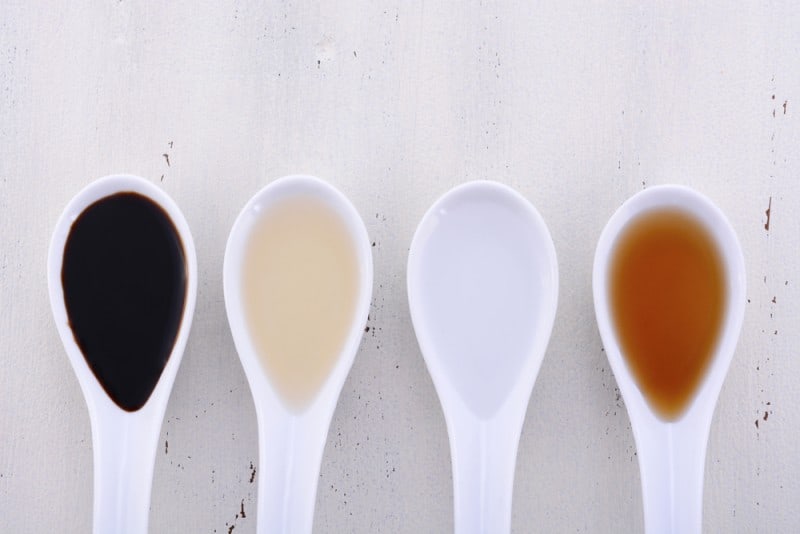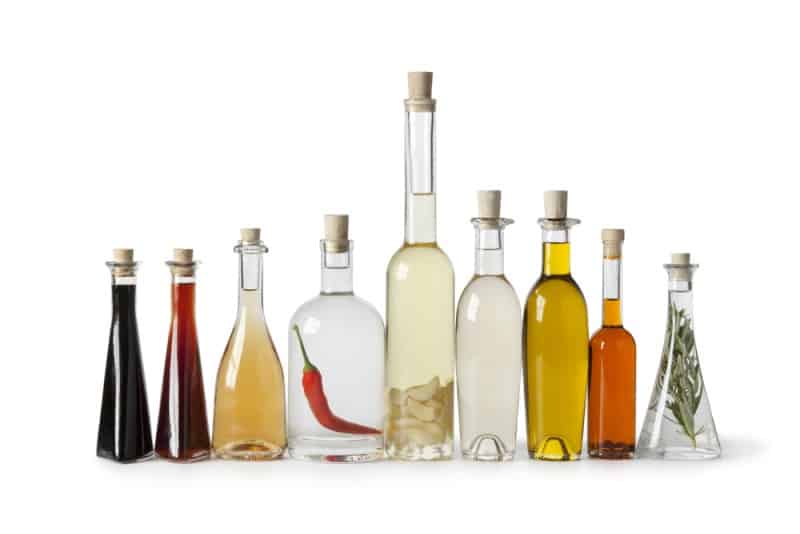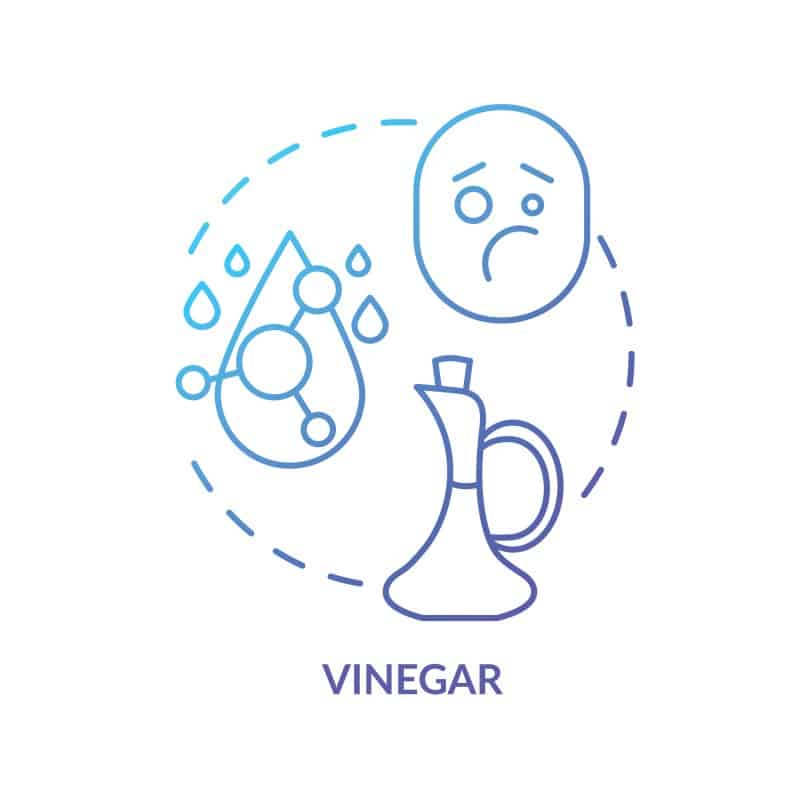Perfect to season salads or to prepare some delicious pickles, vinegar is a fermented product. Luckily for you, it has almost an indefinite shelf life.
Due to the acid nature, vinegar is actually self-preserving, and you don’t need to store it at cold temperatures. One of the most common types, the white vinegar, will remain virtually unchanged for the longest time.
However, some changes in other types of vinegar might appear, such as their color, or some sediments, signs of vinegar going bad. Furthermore, a good indicator of spoiled vinegar can be the aesthetic change.
In addition to sediments and a color change, vinegar can also develop a slimy substance, also popular as “mother” (1), which may look a bit scary to you.
However, it won’t harm your health. But keep on reading to find more about each sign of vinegar going bad, as well as some tricks on storing this solution accordingly.
Types Of Vinegar
Before checking the main ways to figure out if your vinegar has gone bad, let’s understand more about the kinds of vinegar on the market:
1. Balsamic Vinegar
This one is quite the oldest type of vinegar and a more expensive one, as it is aged from 12 to 25 years.
The authentic balsamic vinegar is usually made of grape products, not from wine, as most of the stores’ types. It has an acidity of around 4 percent.
Personal opinion: When it comes to gourmet options, there is no better one on the market than this one.
2. Apple Cider Vinegar
As the name suggests, the apple cider vinegar is made from the “must” or the unprocessed juice of apples, and it is most of the time found unpasteurized.
As such, no wonder why you will find apple cider vinegar with that “mother” still in its bottle. Apple cider vinegar has been used as a health ingredient for centuries now (2), and it has an acidity of 5%.
Personal opinion: You can go with a normal apple cider vinegar or you can choose one that comes with additional layers of taste such as ginger.
3. Distilled White Vinegar
Although the name suggests that this type of vinegar would be produced by distillation well, this is actually untrue. The distilled white vinegar is made by fermentation of distilled alcohol.
The most common material is malt, as it is not expensive at all. However, in the United States, corn is mostly used for getting distilled white vinegar. Now, this type of vinegar comes in cans, most of the time, and it has 5 percent acidity.
Suppose you are looking for a “cleaning vinegar”, with much more acidity. In that case, you can look for one that has 10 percent acidity.
This video will show you the cleaning properties of white vinegar.
4. Wine Vinegar
Wine vinegar is a popular ingredient made of wine (grapes). Compared with the other types of this acid solution, the wine one has lower acidity (4%) than cider vinegar or white vinegar.
Personal opinion: When it comes to brands, Colavita is one of my top picks.
5. Rice Wine Vinegar
The rice wine vinegar (3) is made of two-fold fermentation of sugars, and the main ingredient is rice.
Some manufacturers will also use some rice concentrate of rice that was not distilled. You can find various rice wine vinegar flavors, depending on the grocery store you are shopping.
Compared with other vinegar types, the rice one comes with a milder flavor and an acidity that ranges from 4 percent to 7 percent.
Personal opinion: I prefer this vinegar when cooking Asian recipes, so this is why I like this brand.
Shelf Life Of Vinegar
Like other condiments we can find in the grocery stores, vinegar does not have a precise expiration date. Let’s say that we can talk about a “best before date,” but hardly about an expiration date.
In other words, you are safe to consume almost any type of vinegar even after the “best before date” has lapsed.
Now, according to the Vinegar Institute, you don’t even have to store the vinegar at low temperatures or in the fridge due to the acid nature of this product. Furthermore, because of its self-preserving nature, vinegar can be kept for a long period of time.
However, if you do pay attention to storage, vinegar won’t go bad, but it will lose a lot of its quality and properties.
For instance, the acetic acid that is so present in vinegar can be affected by the water in the air.
Moreover, the humidity can also affect the flavor of the vinegar. Have a look at the table below to check the shelf life of the most popular types of vinegar:
| Type Of Vinegar | Best Quality | Safe To Use |
|
5 years | Indefinitely |
|
Indefinitely | Indefinitely |
|
2 years | Indefinitely |
|
2 to 3 years | Indefinitely |
|
2 years | Indefinitely |
Tips To Tell If Vinegar Has Gone Bad, Spoiled, Or Rotten
If vinegar is generally safe to use indefinitely, how can people know if this condiment has gone bad? Well, like any other fermented product, it should be noted that vinegar, as well, can get spoiled.
There are lots of vinegar types (4), and some of them can go bad, but all will most probably last for a long time. The longest shelf life goes to the white vinegar, which it is safe to say will last the longest and will hardly expire as soon as it is properly stored.
These white distilled varieties of vinegar are made of sun-ripened corn mixed with water, while the apple cider vinegar, the most popular one, is made only from apples and water. This video explains the whole process better.
As long as you will be practicing good hygiene and respecting the food safety techniques, your cider will last a very long time. Due to its acidic nature, vinegar, especially the white distilled ones, will stay basically unchanged.
Signs Of Vinegar Going Bad
However, there might be some situations where vinegar will suffer some changes, and these can be:
- Development of haze
- Cloudiness
- Sediments
- Altered Color
Usually, the most frequent signs of spoiled vinegar are the aesthetic ones. In case you are using some flavored varieties of vinegar, depending on the ingredients that have been added to their composition, you may want to replace that vinegar after a maximum of 10 years. Do not consume it if you notice any change of color and texture.
Another way to notice if the vinegar is still good for consumption is the possible sediments. For instance, an old product from this category might develop a special type of settlement right at the jar’s bottom.
Furthermore, you might experience a cloudy look of the vinegar. These sediments are usually harmless if consumed. However, the initial flavor might get compromised after around 5 years due to the additional ingredients.
Notes!
White vinegar does not have the capacity to extend its shelf life, like many other foods in this category.
Whether you are using champagne, cider, or raspberry vinegar, and you notice that it has gone bad, don’t hesitate to look for some substitutes and use them for your purposes. There are always some health risks when it comes to spoiled foods.
So, remember to practice the safety measures, so you can enjoy your favorite ingredients right before their shelf life expires.
Best Ways To Store Vinegar

The best way to store the vinegar, no matter its type, is in its original air-tight container. This way, it won’t contact any particles in the air.
Also, make sure you keep the bottles of vinegar in the dark, dry place, such as the pantry, away from any heat source. The temperature should be constant, and this is a general rule for any food or drink product.
Do not store the vinegar containers next to a stove or dishwasher, where the usual temperature can increase and become too hot to cool back down again.
Storage Tips For Vinegar
More than maximizing the flavors of any food, proper storage will keep our favorite ingredients fresh for a longer period of time. Here are my favorite tips in storing vinegar to extend its “best shelf life”:
- Make sure you keep the vinegar in a cool place. Use a pantry or a kitchen cabinet
- Once you open the vinegar container, keep this ingredient in its original bottle
- Keep the unopened container of vinegar away from direct sunlight
- Do not throw the lid of the bottle, but put it back once you have finished using the vinegar
Finally
Well, although the shelf life of vinegar is way more extended than other foods, you need to make sure you are storing it right. This way, you will cut the food costs a lot, eat healthier, and also help the environment from food waste.



